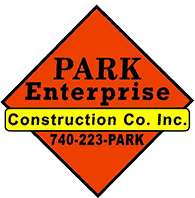
Editor's Note: This blog post was originally posted on March 30th, 2018 and was updated on July 16th, 2018.
Potholes in Central OH are a fact of life. Well, in reality, they can pop up pretty much anywhere there’s enough water to erode your asphalt and sub-base, coupled with enough traffic to speed up the destruction.
As another harsh winter comes to an end, commercial property owners now should begin looking at some parking lot maintenance tactics to repair the damage. After all, your lot is typically the first physical and visual point of contact customers and visitors have with a business or organization. Not to mention, potholes can be a serious legal liability if people are injured or vehicles incur damage on your property.
The correct course of action depends on the severity of the pothole. In some minor cases, you can clean up the wound in your lot, apply some cold patch, and prepare for a more extensive fix later. In others more extreme, it may be necessary to dig down to repair the foundation, fill the hole with construction aggregate stone, and then apply more permanent hot patch.
First Thing's First: How Do Potholes Form?
Death by Water
A gentle spring rain makes the flowers grow, right? Right, but it also slowly kills your lot. Over the millennia, water’s erosive power cuts through miles of bedrock. Even the best commercial parking lots stand little chance when exposed to the elements even for several decades.
Water runoff and poor drainage on a driving surface:
- Erode the top layer
- Seap beneath the top layer and weaken sublayers
This applies to:
- Rain water
- Standing water
- Snow melt
- Ice
Freezing temps are particularly damaging. Water expands by 9% as it turns to ice, forcing cracks and holes open wider. Repeated freezing expansion and thawing contraction has a compounding effect, allowing more water to trickle beneath and erode lower layers.
With lower levels weakened and eroded away, that portion of the driving surface collapses into itself. Bam! Pothole.
Death by Weight
Vehicle weight (about 4,000 pounds for an average midsize car while the federal limit for commercial vehicles is 80,000 pounds) grounds and pounds your commercial parking lot over time.
Any manmade structure that continually withstands many tons of pressure will eventually crumble. Potholes form when the driving surface simply can no longer carry the load.
Your parking lot repair schedule can give your lot renewed strength.
Death by Poor Maintenance
An experienced asphalt paving company, however, will plan adequate layering and strong joints to help your lot accommodate volumes of traffic for longer. But like any construction job, it’ll still require upkeep.
Regularly scheduled parking lot repair jobs should include:
- Sealcoating every few years
- Frequently checking and filling new cracks and holes
- Fixing potholes before they become craters
- Weeding cracks
- Cleaning engine oil spots
- Painting fresh parking stripes
Patch it and you’re done, right?
Wrong! Take a good look at the situation and choose the most viable and effective options based on need. Many commercial property owners simply need a temporary fix while they get their financial house in order for a complete parking lot overhaul.
So whether you have one big depression or your lot is pockmarked and cratered like the surface of the Moon, here are some DIY parking lot repair tips and options for how to fix a pothole.
Dig Out the Junk
There could be a considerable amount of debris at the bottom of a pothole. This could include:
- Pieces of the driving surface above that crumbled and fell in
- Eroding dirt and subgrade beneath
- Roadside garbage
- & More
It’s even possible to dig down and find pieces of rotting wood from old tree stumps or barrels buried and forgotten long ago. (Remember: Potholes usually collapse from a weak, unsupportive subgrade.) Get rid of all of the stuff within and cast it aside. You don’t want to reuse base material that has already proven itself weak.
Fill with New Base Material
Now you’re faced with an empty hole. Fill it.
Depending on its depth, you may need to establish a new solid foundation from construction aggregate stone. The best gauge for this is #304 aggregate - stones which measure from about 1.5” down to fine grains - for its firm compactability. Above that, you (or an experienced contractor) should then apply fresh asphalt.
But don’t just pour the aggregate in and call it good. Lay equal and level layers about 3” thick, and tamp them down solid to about 1”-1.5” for proper compaction. Then repeat the process with more equal layers until you reach the surface of the hole.
Compaction equals strength. (Remember: Strength is even more critical because this part of your asphalt parking lot has clearly failed before.)
Mill & Square
You’ll soon face the decision between cold and hot patching. When you fill in the hole with new asphalt, it must uniformly fill the void and marry up with the previously existing asphalt.
But who’s ever seen a perfectly square or round pothole perfectly ready to be filled by a perfect amount of new asphalt?
You or your contractor can mill down the existing asphalt surrounding the pothole. What remains should be a square or rectangular void that’s perfectly edged and ready to receive fresh asphalt.
Cold Patch
This option is only temporary. A cold mix of aggregate, recycled asphalt, and tar-like asphalt binder can be:
- Poured into the squared hole
- Leveled off
- Tamped down
- Compacted
- Repeated in layers, when necessary
This quick fix is merely an inexpensive bridge to greater parking lot repair or replacement options.
Hot Patch
This method uses the real deal: Hot mix asphalt. In a similar process, the hot asphalt is poured into the hole, leveled, and compacted. This kind of pothole repair is stronger and will last longer.
You or your contractor also must seal the joints (where new asphalt meets old) with rubberized crack filler for a sturdier connection.
But beware: A temporary patch is a temporary patch. The time will come when patches are no longer a viable option for your commercial parking lot.
Roll It
New asphalt requires rolling for optimal leveling and compaction. It may sometimes look or feel unnecessary, but nothing is better than rolling to ensure the material is fully compacted and strong.
Factor Adequate Drainage
Chances are water erosion caused your pothole(s) in the first place. Unless your parking lot plans on becoming a desert in the near future, water problems are sure to continue.
Installing a storm sewer or gravitational drainage system may be necessary in trouble areas to keep water from pooling and causing more damage.
Create a Parking Lot Repair Plan for Fixing Potholes & More
With the pothole fixed, your commercial parking lot is functional again. You may have saved thousands (or even millions) of dollars in potential litigation. And, at least for now, your asphalt parking lot is functional and attractive enough to keep your customers and visitors happy.
But always keep in mind, there will come a time when your lot has outlived its useful life. It’ll begin to look ugly like these examples. When that day comes, call a professional asphalt contractor with a track record of building great parking lots in Central OH.




